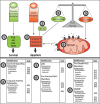Regulation of human neutrophil apoptosis and lifespan in health and disease
- PMID: 25278783
- PMCID: PMC4167320
- DOI: 10.4137/JCD.S11038
Regulation of human neutrophil apoptosis and lifespan in health and disease
Abstract
Neutrophils (also called polymorphonuclear leukocytes, PMNs) are the most abundant white blood cells in humans and play a central role in innate host defense. Another distinguishing feature of PMNs is their short lifespan. Specifically, these cells survive for less than 24 hours in the bloodstream and are inherently pre-programed to die by constitutive apoptosis. Recent data indicate that this process is regulated by intracellular signaling and changes in gene expression that define an "apoptosis differentiation program." Infection typically accelerates neutrophil turnover, and as such, phagocytosis-induced cell death (PICD) and subsequent clearance of the corpses by macrophages are essential for control of infection and resolution of the inflammatory response. Herein we reprise recent advances in our understanding of the molecular mechanisms of neutrophil apoptosis with a focus on regulatory factors and pathway intermediates that are specific to this cell type. In addition, we summarize mechanisms whereby perturbation of PMN death contributes directly to the pathogenesis of many infectious and inflammatory disease states.
Keywords: Bax; Mcl-1; PCNA; apoptosis differentiation program; caspases; constitutive apoptosis; extrinsic pathway; gene expression; intracellular signaling; intrinsic pathway; pathogen; phagocytosis-induced cell death.
Figures


References
-
- Hsieh MM, Everhart JE, Byrd-Holt DD, Tisdale JF, Rodgers GP. Prevalence of neutropenia in the U.S. population: age, sex, smoking status, and ethnic differences. Ann Intern Med. 2007;146(7):486–492. - PubMed
-
- Saverymuttu SH, Peters AM, Keshavarzian A, Reavy HJ, Lavender JP. The kinetics of 111indium distribution following injection of 111indium labelled autologous granulocytes in man. Br J Haematol. 1985;61(4):675–685. - PubMed
-
- Nauseef WM. How human neutrophils kill and degrade microbes: an integrated view. Immunol Rev. 2007;219:88–102. - PubMed
-
- Schiffer CA. Hyperleukocytosis and leukostasis. In: Larson RA, editor. UpToDate. Waltham, MA: UpToDate; 2012. www.uptodate.com.
Publication types
Grants and funding
LinkOut - more resources
Full Text Sources
Other Literature Sources
Research Materials
Miscellaneous

